Slbqt-Dsr: Source - based load balancing routing algorithm under constraints of quality of transmision for manet
With the trends in the development of communication network technologies, the wireless communications is one of the decisive solutions for the transmission technology of the
telecommunications network in general and the computer network in particular. In the era
of the fifth generation (5G) wireless network and Internet of things (IoT), there are several
wireless network models to provide the practical applications such as MANET, wireless sensor networks (WSN), wireless mesh networks (WMN), and hybrid wireless networks [25].
Among these types, MANET is a network model that operates according to the principle of
peer-to-peer networks, it does not depend on a preexisting infrastructure. A network model
can be deployed easily and flexibly. Thus MANET is becoming more and more widely used
in many fields, such as community network, enterprise network, home network, emergency
response network, vehicle network, sensor network [18].
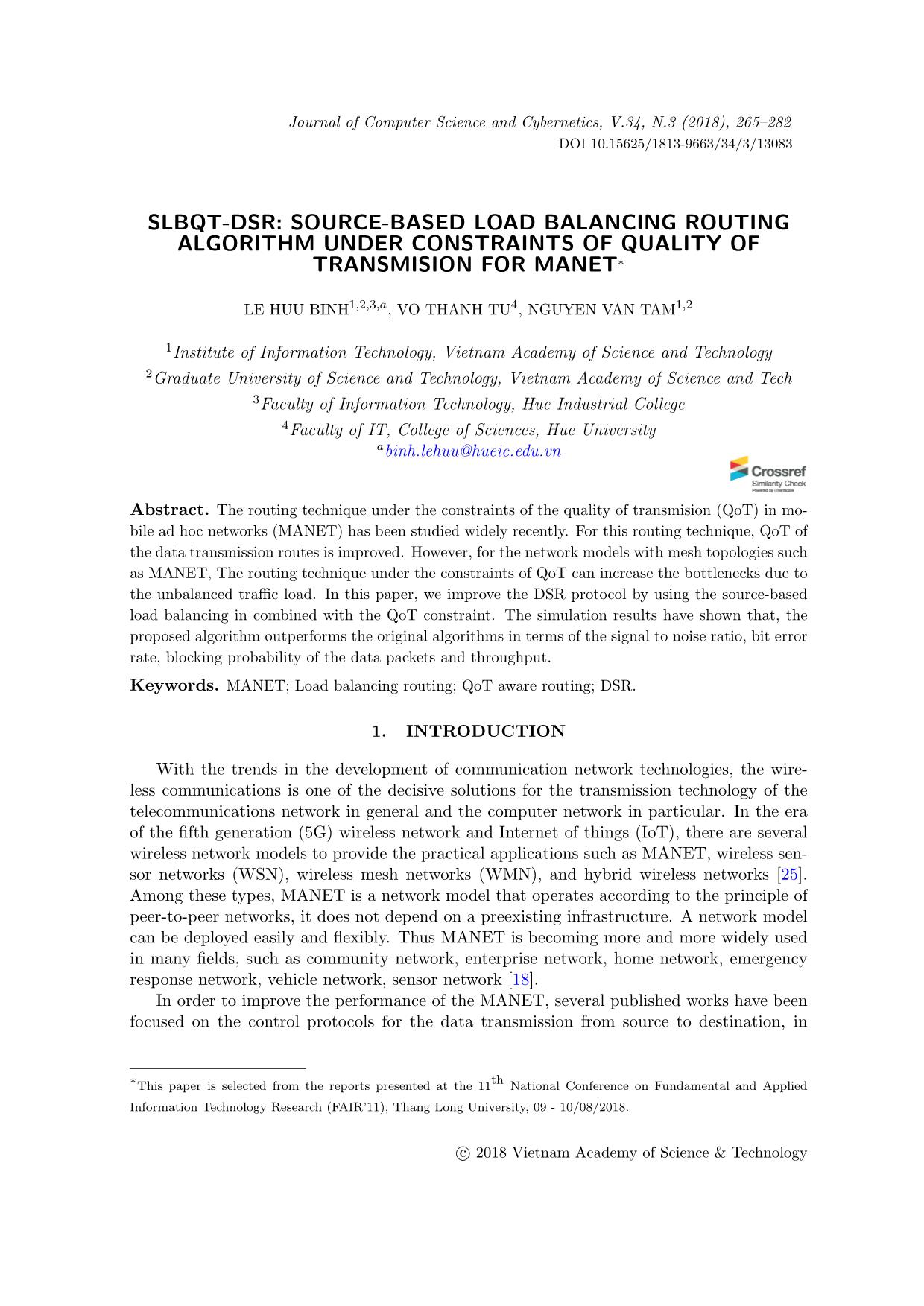
Trang 1
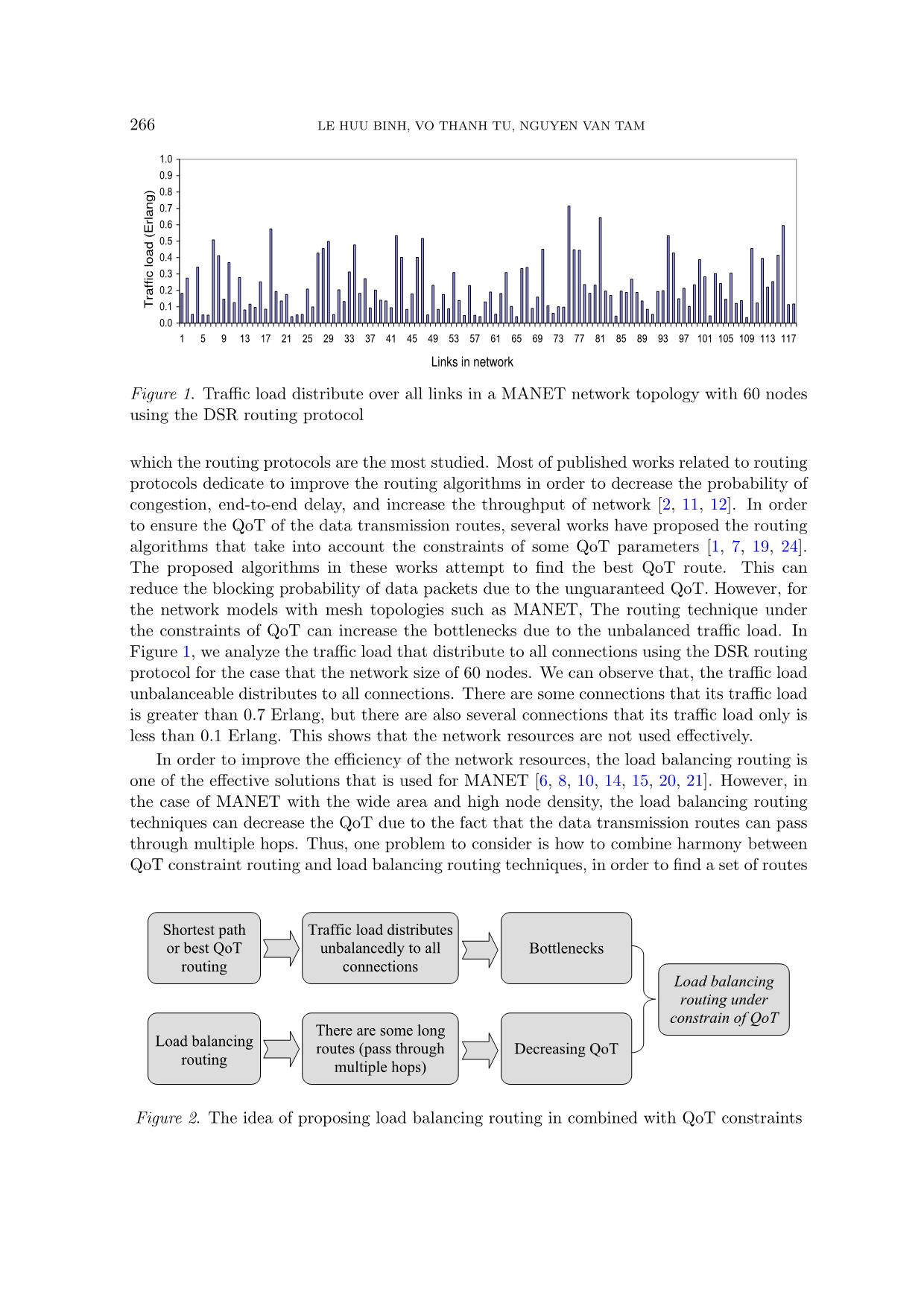
Trang 2
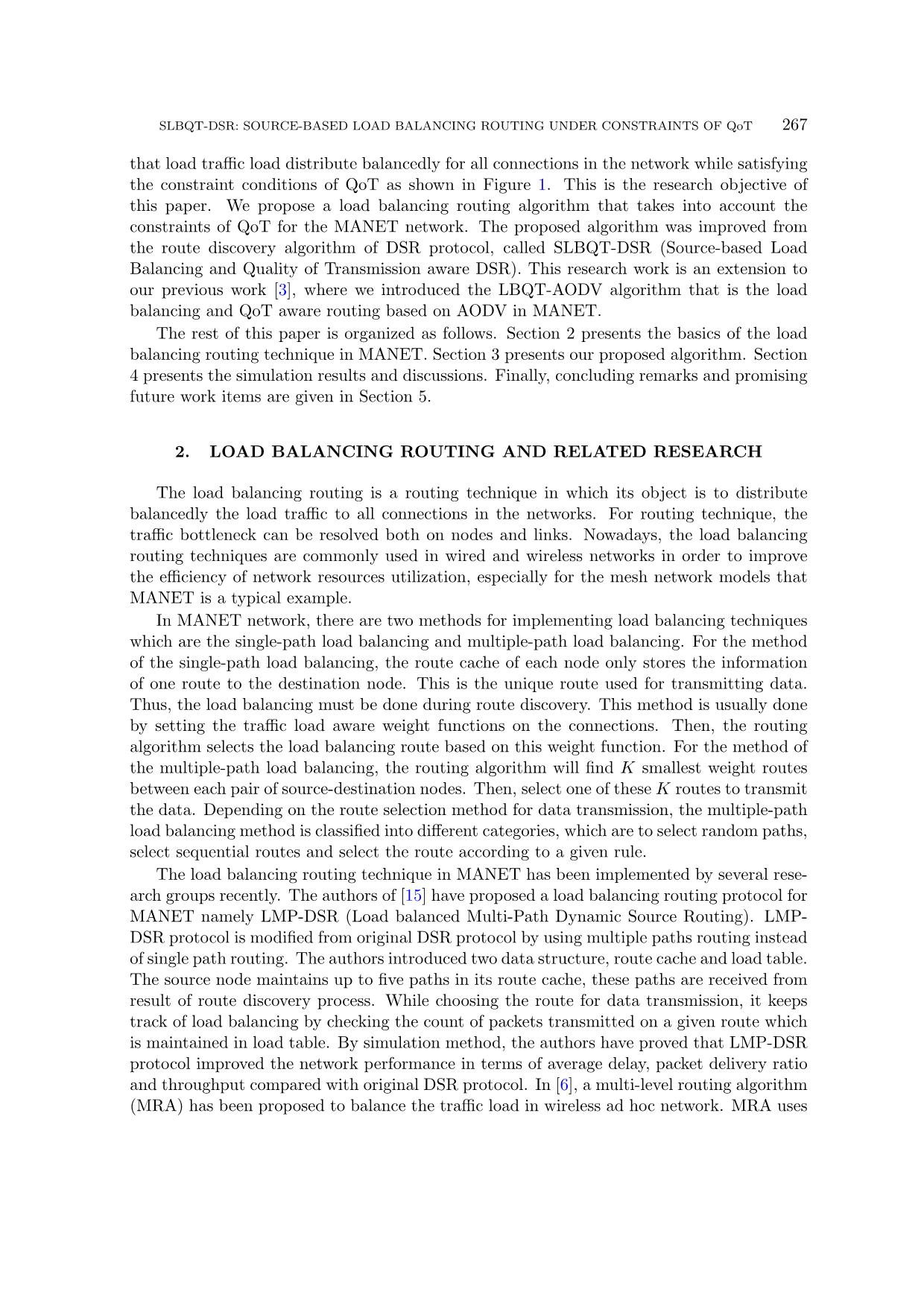
Trang 3
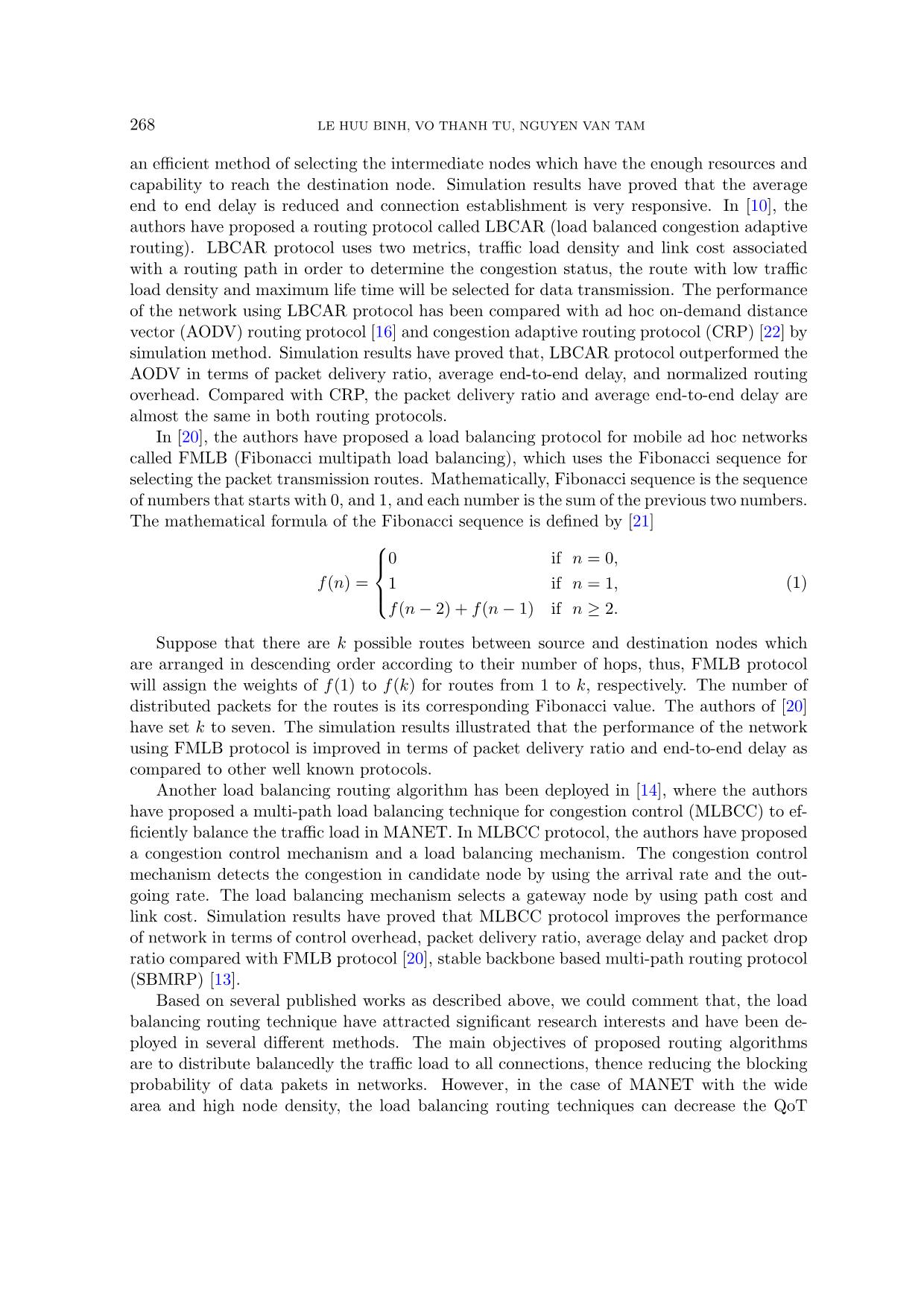
Trang 4

Trang 5
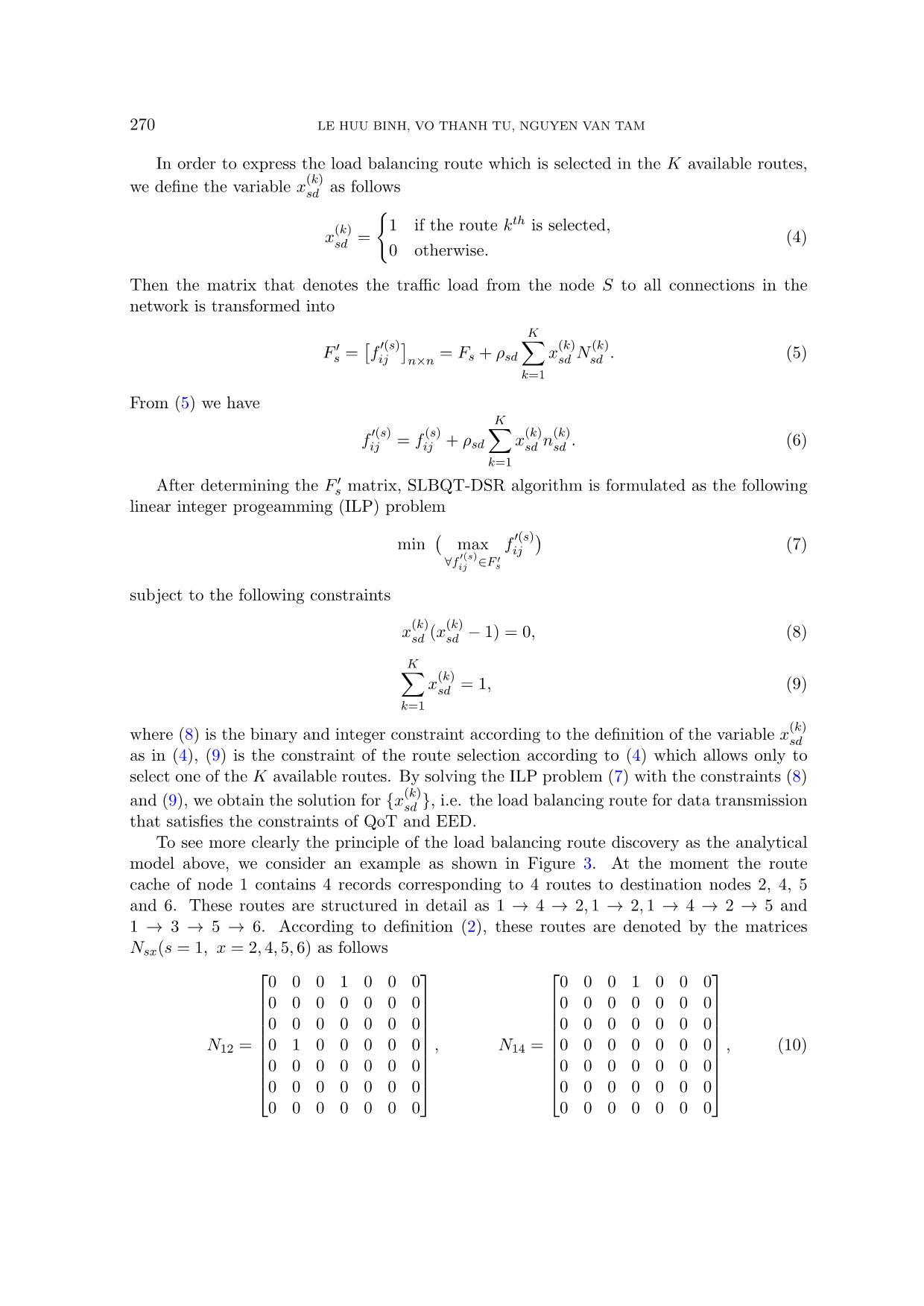
Trang 6
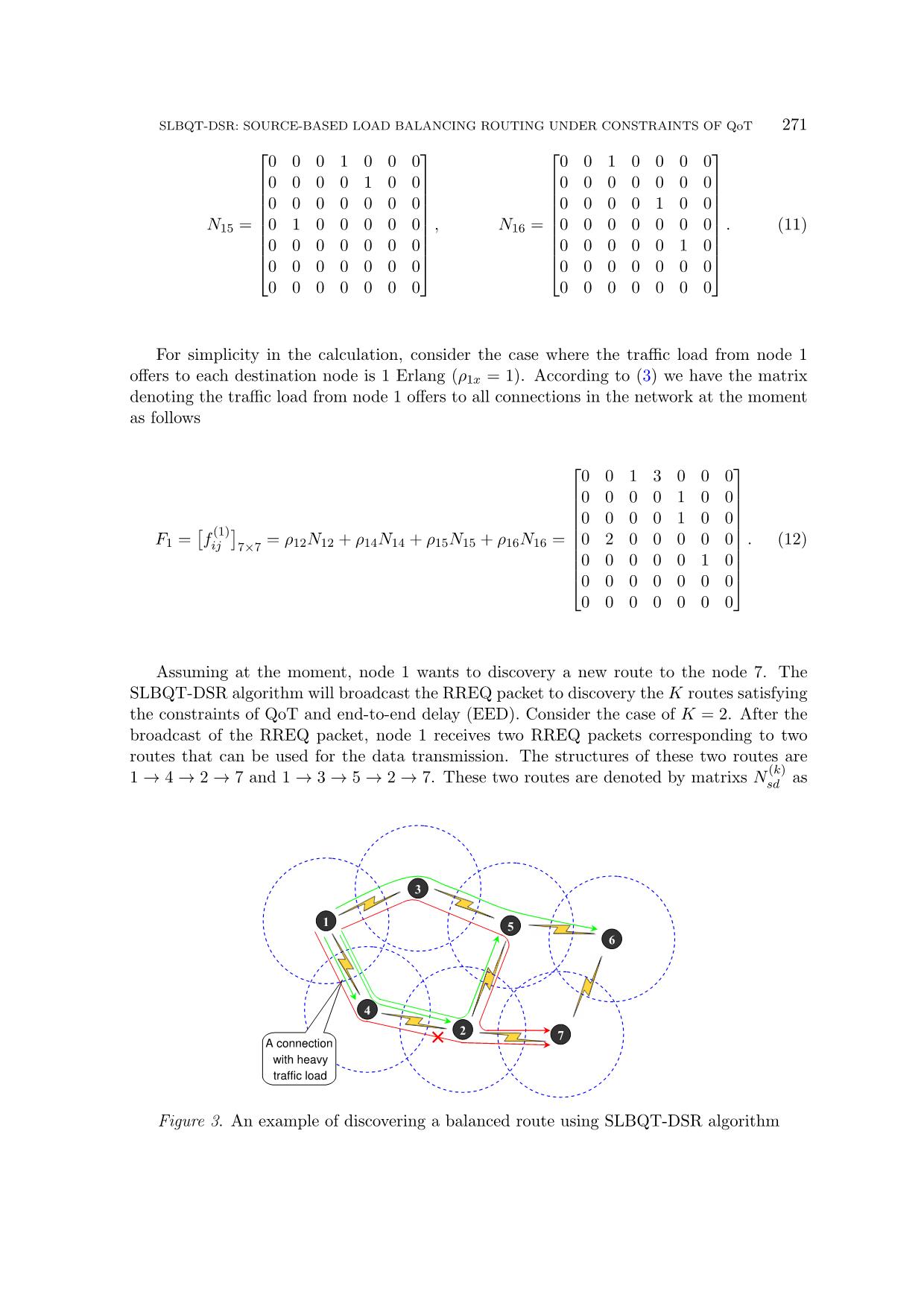
Trang 7
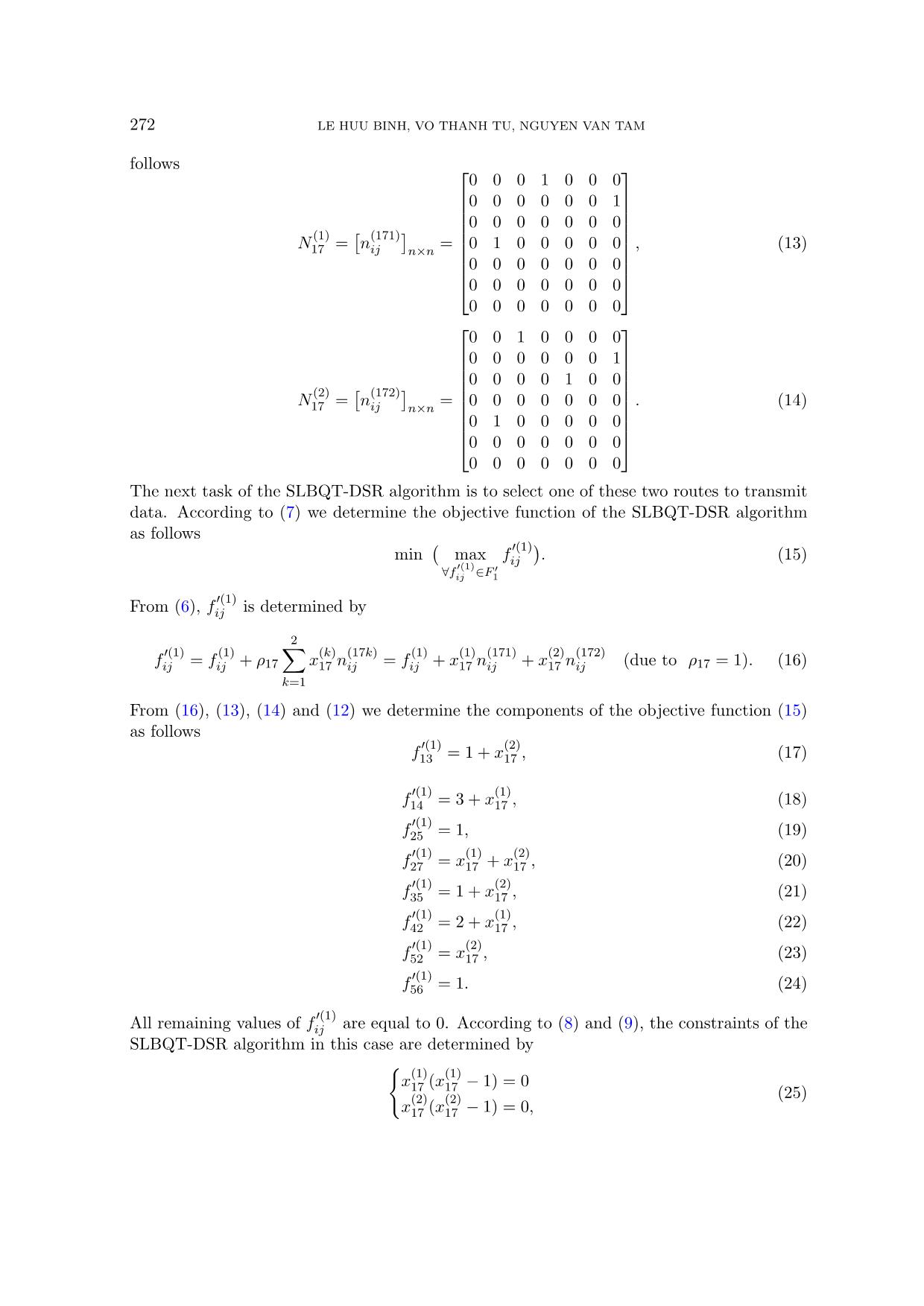
Trang 8
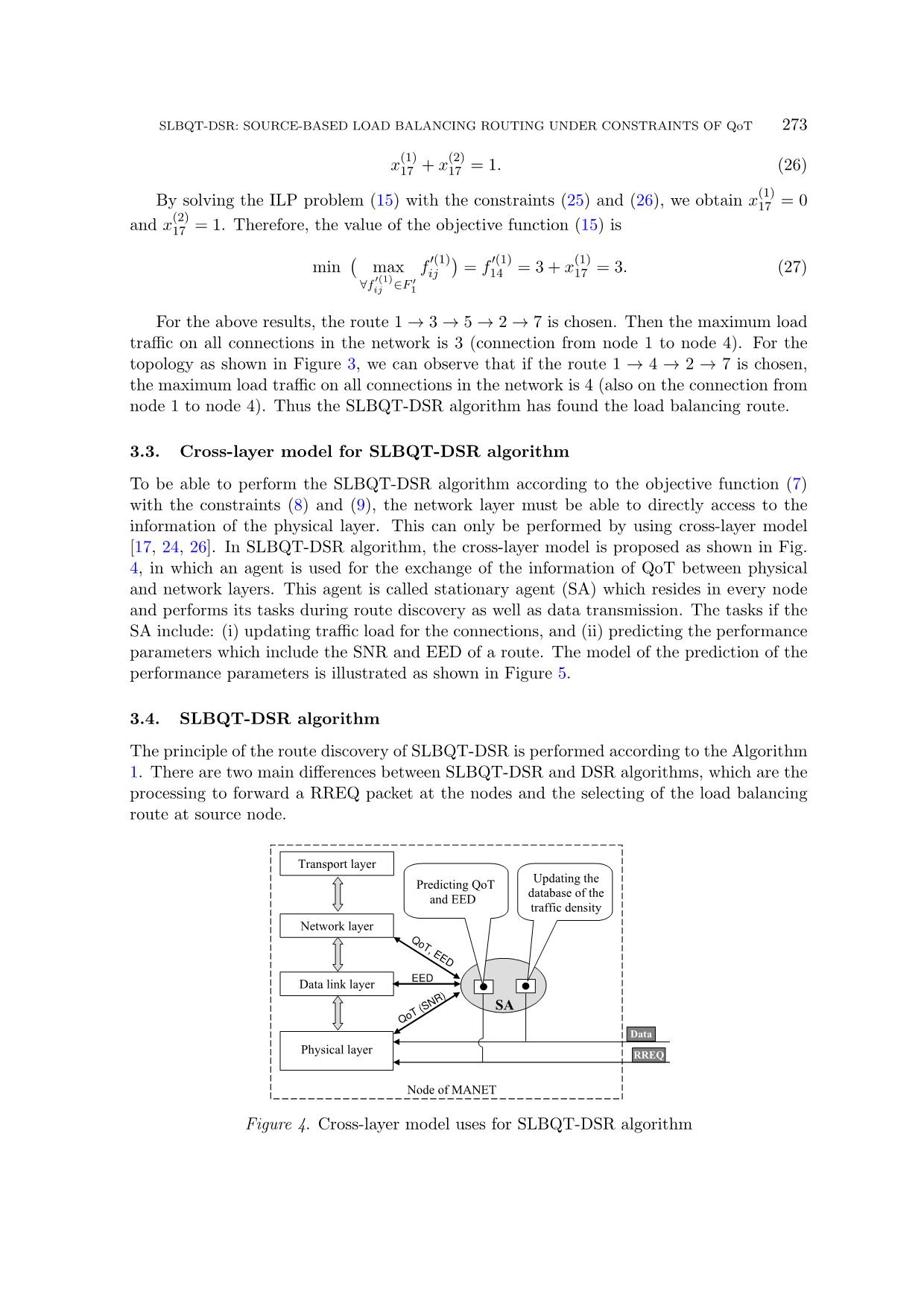
Trang 9
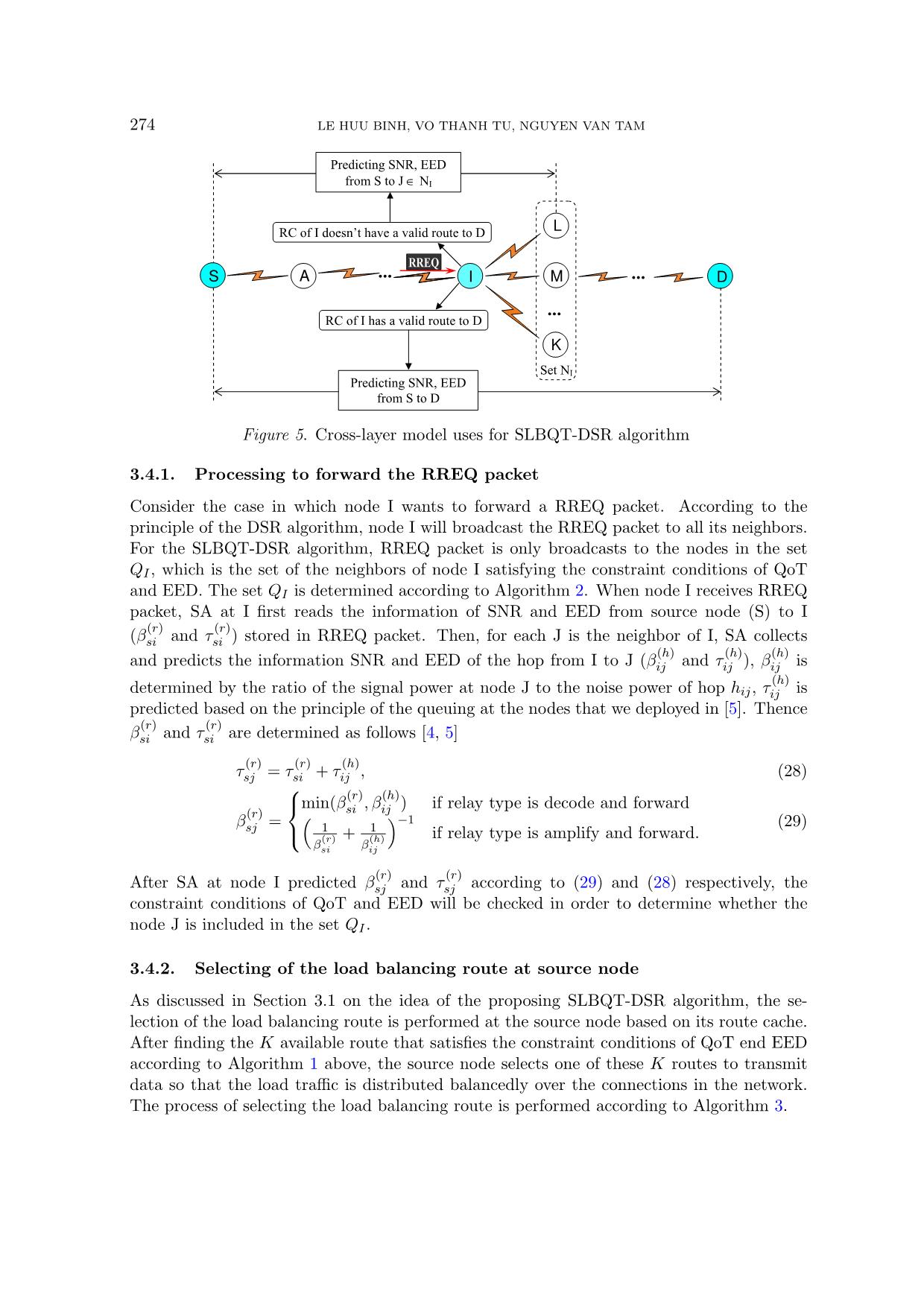
Trang 10
Tải về để xem bản đầy đủ
Tóm tắt nội dung tài liệu: Slbqt-Dsr: Source - based load balancing routing algorithm under constraints of quality of transmision for manet
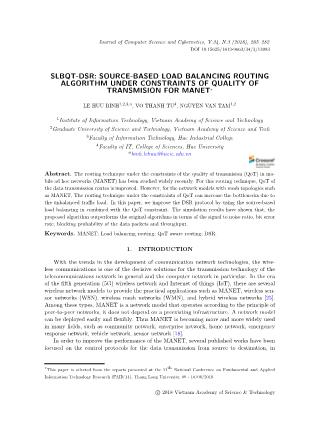
t the traffic distribution matrix Fs = [ f (s) ij ] n×n according to (3); 2: Based on the information of K available routes, construct the traffic dis- tribution matrix F ′s = [ f ′(s) ij ] n×n according to (5); 3: Construct the ILP problem according to the objective function(7) subject to the constraints of (8) and (9); 4: Solving the ILP problem; 5: Select the load balancing route based on the results of the ILP problem solving; 6: Update the information of the found route into the route cache of S; 4. SIMULATION RESULTS AND DISCUSSION 4.1. Simulation scenarios In order to evaluate the performance of SLBQT-DSR algorithm, we use the simula- tion method based on OMNeT++ discrete event simulator [23]. LBQT-DSR algorithm is compared with DSR [9] and QTA-DSR algorithms [5] in terms of the SNR, BER, blocking probability of the data packet, and network throughput. The simulation assumptions are presented in Table 1. In addition, for each simulation scenario, the number of source nodes SLBQT-DSR: SOURCE-BASED LOAD BALANCING ROUTING UNDER CONSTRAINTS OF QoT 277 is set to 30% of the the number of nodes, the remaining nodes are the destination nodes. For example, for the scenarios of 30 nodes, there are 10 source nodes and 20 destination nodes. Table 1. Simulation parameters Parameters Setting Parameters Setting Network Size 1000 m × 1000 m BER threshold 10−6 Modulation technique 256-QAM Minimum Required SNR 23.5 dB MAC protocol 802.11ac Noise model Thermal noise Number of nodes From 20 to 50 Temperature 3000K Transmit Power 19.5 dBm Mobility model Random - Waypoint Receiver Sensitivity -68 dBm Speed of nodes 5 - 20 m/s Transmission Range 250 m Time simulation 40 minutes 4.2. Performance analysis 4.2.1. Evaluation of SNR and BER The obtained results in Figure 6 show the SNR of all routes for the cases that DSR and SLBQT-DSR algorithms are used. In this case, the networks size is 50 nodes, the channel bandwidth is 40 MHz and the average mobility speed is 20 m/s. According to the simulation scenarios presented in Section 4.1, the minimum required SNR for ensuring QoT is 23.5 dB. From the curves in Figure 6a, we can observe that for DSR algorithm, there are many routes do not satify the constraint conditions of QoT due to the fact that its SNR is less than required SNR. These routes account for 1.58%. This is the cause of the increasing the packet blocking probability due to the unsatisfactory constraint conditions of QoT. For SLBQT-DSR algorithm, SNR values improved significantly compared with DSR algorithm. This is more clearly visible from Figure 6b, where we analyzed the SNR of all routes when SLBQT-DSR is used. Most of the routes satify the constraint conditions of QoT due to the fact that the QoT constraints were considered during the route discovery. Since SNR decreases in case of the SLBQT-DSR is used, BER increases as shown in Figure 7, where, we plot the BER of the routes as a function of the simulation times. In Figure 6. The comparison the of SNR of (a) DSR and (b) SLBQT-DSR algorithms 278 LE HUU BINH, VO THANH TU, NGUYEN VAN TAM Figure 7. The comparison of the BER of (a) DSR and (b) SLBQT-DSR algorithms this case, the network size is 50 nodes, the channel bandwidth is 40 MHz and the average mobility speed is 20 m/s. We can observe that, for DSR algorithm (Figure 7a), there are many routes that its BER is greater than 1e-6. These routes do not satify the constraint conditions of QoT. For SLBQT-DSR algorithm (Figure 7a), As the constraint conditions of QoT ware considered during route discovery, most of the routes are that its BER is within allowable limits, i.e it is less than 1e-6. 4.2.2. Evaluation of blocking probability The blocking probability of data packets (BPD) is an important parameter with regard to the network performance. In our context, BPD is given by BPD = Nb Ng , (30) where Ng and Nb are the number of data packets are generated and the number of data pac- kets are blocked in the overall network respectively. Nb includes two components, blocking due to the congestion of the traffic load and blocking due to unsatisfactory constraint con- ditions of QoT. The obtained results in Figure 8 show the difference in the BPD of DSR, QTA-DSR and SLBQT-DSR, where, we plot the BPD as a function of the traffic load in Erlang. These results are simulated for the case that the number of node is 30, the average mobility speed of the nodes is 20 m/s and the channel bandwidth is 40 MHz. The curves in Figure 8 show that, if the traffic load is less than 0.8 Erlang, BPD of both QTA-DSR and SLBQT-DSR are almost similar. In case of heavy traffic load, i.e from 0.8 to 1 Erlang, BPD of LBQT-DSR algorithm reduced significantly compared with that of QTA-DSR algorithm. Considering the case of the traffic load is 1 Erlang, BPD of QTA-DSR and LBQT-DSR algorithms are 0.031 and 0.025, respectively. Thus BPD of LBQT-DSR algorithm reduced by 0.0053 compared with that of QTA-DSR algorithm. Next, we analyze the case of the variable network size. The results obtained as shown in Figure 9, where, we compared the BPD of the algorithms DSR, QTA-DSR and SLBQT-DSR. These results are implemented for the case that the average mobility spend of the nodes is SLBQT-DSR: SOURCE-BASED LOAD BALANCING ROUTING UNDER CONSTRAINTS OF QoT 279 0.00 0.01 0.02 0.03 0.04 0.05 0.06 0.6 0.65 0.7 0.75 0.8 0.85 0.9 0.95 1 Traffic load (Erlang) BP D DSR QTA-DSR SLBQT-DSR Figure 8. The comparison BPD versus the traffic load of DSR, QTA-DSR and SLBQT- DSR algorithms 0 0.01 0.02 0.03 0.04 0.05 30 35 40 45 50 Network size (nodes) BP D DSR QTA-DSR SLBQT-DSR Figure 9. The comparison BPD versus the network size of DSR, QTA-DSR and SLBQT-DSR algorithms 5m/s, the channel bandwidth is 40 MHz, and the traffic load is 0.95 Erlang. We can observe that, for all algorithms, the larger the network size, the higher the PBD, due to the fact that QoT decreases according to the network size. However, BPD of SLBQT-DSR algorithm is always less than the other two algorithms. The average PBD reduction rate by 53.54% and 29.26% compared with DSR and QTA-DSR algorithms, respectively. For the cases of the variable mobility speed, PBD of all three algorithms increases accor- ding to the mobility speed of the nodes. This is more clearly visible from Figure 10. These results are implemented for the case that the networks size and traffic load are 40 nodes and 0.95 Erlang, respectively. We can observe that, PBD reduced significantly in the cases of QTA-DSR and SLBQT-DSR algorithms is used. In particular, the SLBQT-DSR algorithm has the lowest BPD value, with a mean decrease of 46.72% compared to the DSR algorithm. 0 0.01 0.02 0.03 0.04 0.05 0.06 0.07 5 10 15 20 Mobility speed (m/s) BP D DSR QTA-DSR SLBQT-DSR Figure 10. The comparison BPD versus the mobility speed of DSR, QTA-DSR and SLBQT-DSR algorithms 56E+6 58E+6 60E+6 62E+6 64E+6 66E+6 68E+6 70E+6 72E+6 74E+6 0 50 100 150 200 250 300 350 400 SLBQT-DSR DSR Simulation times (s) Th ro ug hp ut (b it/s ) Figure 11. The comparison throughput versus the simulation times of DSR and SLBQT-DSR algorithms 280 LE HUU BINH, VO THANH TU, NGUYEN VAN TAM 4.2.3. Evaluation of throughput In this section, we analyze the average receiving throughput at each node. In Figure 11, we plot the average throughput of each node as a function of simulation times for the case that the network size is 50 nodes, the average mobility spend of the nodes is 5 m/s, and the traffic load is 0.9 Erlang. The curves in Figure 11 show that, the throughput of SLBQT-DSR algorithm increases significantly compared with DSR algorithm. The average throughput of SLBQT-DSR and DSR algorithms are 67.385 and 65.482 Mbps, respectively. Thus, average throughput of SLBQT-DSR increases 1.903 Mbps compared with DSR algorithm. 5. CONCLUSION The load balancing routing is one of the optimal routing techniques to improve the network performance of MANET network. With load balancing routing techniques, the local congestion at some connections as well as intermediate nodes is minimized due to the fact that traffic is distributed evenly for all connections in the network. However, for the wide area and high node density MANET, the load balancing routing techniques can decrease the QoT and increase the EED due to the fact that the data transmission routes can pass through multiple hops. In this paper, we proposed a load balancing routing algorithm for MANET taking into account the constraint of QoT and EED. The proposed algorithm is called SLBQT-DSR which is improved from the route discovery algorithm of the DSR protocol. The performance of SLBQT-DSR algorithm is demonstrated by the simulation method using OMNeT++. The simulation results have shown that the proposed algorithm can improve the network performance in terms of SNR, BER, blocking probability and throughput compared with DSR and QTA-DSR algorithms. In the near future, we continue to study the load balancing routing techniques taking into account the QoT with respect to the other routing protocols of MANET, specially for multi-channel MANET networks. REFERENCES [1] F. Alnajjar, “SNR/RP aware routing model for MANETs,” Journal of Selected Areas in Tele- communications (JSAT), pp. 40–48, 2011. [2] H. Bakhsh and M. Abdullah, “ARPM: Agent-based routing protocol for MANET,” International Journal of Internet Protocol Technology, vol. 3, no. 2, pp. 136–146, 2008. [3] L. H. Binh, V. T. Tu, and N. V. Tam, “A load balancing routing algorithm under constraint of quality of transmission in MANET,” in Proceedings of the 11th National Conference on Funda- mental and Applied Information Technology Research (FAIR’11), 2018. [4] L. H. Binh and V. T. Tu, “QTA-AODV: An improved routing algorithm to guarantee quality of transmission for mobile Ad Hoc networks using cross-layer model,” Journal of Communications, vol. 13, no. 7, pp. 338–349, 2018. [5] L. H. Binh, V. T. Tu, and N. V. Tam, “Quality of transmission aware routing in adhoc networks based on cross-layer model combined with the static agent,” Journal of Computer Science and Cybernetics, vol. 32, no. 4, pp. 351–366, 2016. SLBQT-DSR: SOURCE-BASED LOAD BALANCING ROUTING UNDER CONSTRAINTS OF QoT 281 [6] K. J. Dsouza and S. M, “MRA: Multi-level routing algorithm to balance the traffic load in wireless Ad hoc network,” in Proceedings of National Conference on Parallel Computing Technologies (PARCOMPTECH), Feb 2015, pp. 1–5. [7] M. Elshaikh, M. F. M. Fadzil, N. Kamel, and C. M. N. C. Isa, “Weighted signal-to-noise ratio average routing metric for dynamic sequence distance vector routing protocol in mobile Ad-Hoc networks,” in Proceedings of IEEE 8th International Colloquium on Signal Processing and its Applications (CSPA), 2012, pp. 329–334. [8] S. G. and R. A., “Efficient and secure routing protocol for wireless sensor networks through SNR based dynamic clustering mechanisms,” Journal of Communications and Networks, vol. 15, no. 4, pp. 422–429, 2013. [9] D. Johnson, Y. Hu, and D. Maltz, “The dynamic source routing protocol (DSR) for mobile Ad Hoc networks for IPv4,” RFC4728, [Online]. Available: txt. [Online]. Available: [10] J. Y. Kim, G. S. Tomar, L. Shrivastava, S. S. Bhadauria, and W. H. Lee, “Load balanced congestion adaptive routing for mobile Ad Hoc networks,” International Journal of Distributed Sensor Networks, vol. 2014, 2014, [Online]. Available: [11] E. Kulla, M. Ikeda, L. Barolli, F. Xhafa, M. Younas, and M. Takizawa, “Investigation of AODV throughput considering RREQ, RREP and RERR Packets,” in Proceedings of 27th International Conference on Advanced Information Networking and Applications, Barceona, Spain, Mar 2013, pp. 169–174. [12] H. Li, C. Dan, W. Min, and L. Shurong, “Mobile agent based congestion control AODV rou- ting protocol,” in Proceedings of the 4th International Conference on Wireless Communications, Networking and Mobile Computing, 2008, pp. 1–4. [13] S. Mallapur and S. R. Patil, “Route stability based on demand multipath routing protocol for mobile Ad Hoc networls,” in Proceedings of Interational Conference on Communication and Signal Processing, India, April 2014, pp. 1859–1863. [14] S. V. Mallapur, S. R. Patil, and J. V. Agarkhed, “Load balancing technique for congestion control multipath routing protocol in MANETs,” Wireless Personal Communications, vol. 92, no. 2, pp. 749–770, 2017. [15] L. K. Malviya and D. Tiwari, “LMP-DSR: Load balanced multi-path dynamic source routing protocol for mobile Ad-Hoc network,” in Proceedings of Fourth International Conference on Computing, Communications and Networking Technologies (ICCCNT), July 2013, pp. 1–5. [16] C. Perkins, E. B. Royer, and S. Das, “Ad hoc on-demand distance vector (AODV) routing,” RFC 3561, [Online]. Available: https://www.ietf.org/rfc/rfc3561.txt. [17] V. R, M. V, and S. V, “Cross-layer approach among physical, MAC and routing layer in a shadowing environment,” International Journal of Engineering and Technology (IJET), vol. 5, no. 2, p. 1, 2013. [18] S. K. Sarkar, T. G. Basavaraju, and C. Puttamadappa, Ad Hoc Mobile Wireless Networks - Principles, Protocols, and Applications. Taylor & Francis Group, LLC, 2008. [19] S. Srivastava and A. K. Daniel, “An efficient routing protocol under noisy environment for mobile ad hoc networks using fuzzy logic,” International Journal of Advanced Research in Artificial Intelligence, vol. 2, no. 6, pp. 34–39, 2013. 282 LE HUU BINH, VO THANH TU, NGUYEN VAN TAM [20] Y. Tashtoush, O. Darwish, and M. Hayajneh, “Fibonacci sequence based multipath load balan- cing approach for mobile Ad Hoc networks,” Ad Hoc Networks, vol. 16, pp. 237–246, 2014. [21] Y. M. Tashtoush and O. A. Darwish, “A novel multipath load balancing approach using fibonacci series for mobile Ad Hoc networks,” International Journal of Computer Theory and Engineering, vol. 4, no. 2, pp. 220–225, 2012. [22] D. A. Tran and H. Raghavendra, “Congestion adaptive routing in mobile Ad Hoc networks,” IEEE Transactions on Parallel and Distributed Systems, vol. 17, no. 11, pp. 1294–1305, 2006. [23] A. Varga, OMNeT++ Discrete Event Simulation System, Release 4.6, 2015, [Online]. Available: [24] A. Yadav and T. Sharma, “Cross-layer approach for communication in MANET,” International Journal of Computer Science and Mobile Computing, vol. 4, no. 3, pp. 285–292, March 2015. [25] Y. Zhang, J. Luo, and H. Hu, Wireless Mesh Networking - Architectures, Protocols and Stan- dards. Taylor & Francis Group, LLC, 2007. [26] M. M. zoulikha and B. Amal, “Cross-layer approach among physical, MAC and routing layer in a shadowing environment,” Ad-Hoc and Sensor Wireless Networks, vol. 21, no. 1-2, pp. 101–119, 2014. Received on September 09, 2018 Revised on September 28, 2018
File đính kèm:
 slbqt_dsr_source_based_load_balancing_routing_algorithm_unde.pdf
slbqt_dsr_source_based_load_balancing_routing_algorithm_unde.pdf

